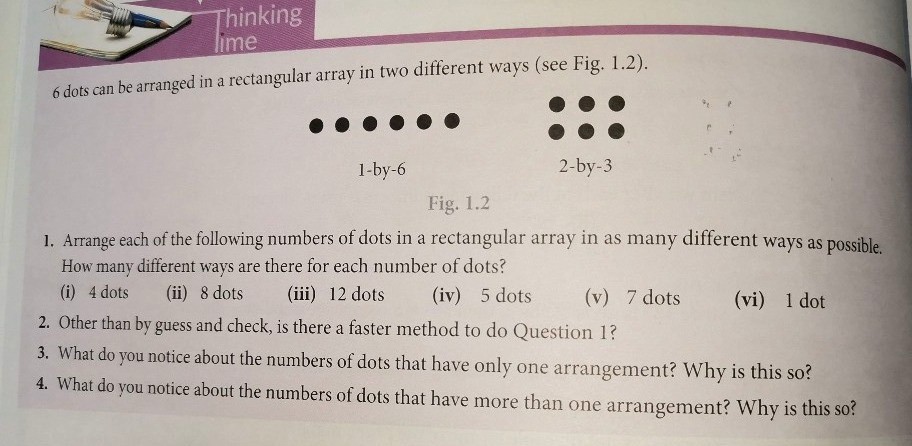Ask Singapore Homework?
Upload a photo of a Singapore homework and someone will email you the solution for free.

Question
Secondary 1 | Maths
One Answer Below
Anyone can contribute an answer, even non-tutors.

Please help!!!
VERY URGENT PLEASE HELP!
thanks
(i) 4 can be written as 1 x 4 or 2 x 2 (here, 4 x 1 is treated to be the same as 1 x 4)
(ii) 8 can be written as 1 x 8 or 2 x 4.
(iii) 12 can be written as 1 x 12, 2 x 6 or 3 x 4.
(iv) 5 can be written as 1 x 5.
(v) 7 can be written as 1 x 7.
(vi) 1 can be written as 1 x 1.
For Q2, rather than listing out everything, all we need to do is to consider all the possible factors of a given number.
For Q3, the single arrangement indicates that the number of dots is either 1 or a prime number (note that 1 is NOT a prime number).
For Q4, the multiple arrangements indicate that the number of dots is a composite number (basically, numbers which are not 1 and not prime)
and i dont really understand what you were saying about question 1
The number of dots can be thought of as the length * breadth of the rectangle.
We need to find values of “length” and “breadth” such that they multiply to the given number of dots.
For example, 4 dots can be arranged into a length * breadth configuration of 4 * 1 or 2*2.
In the representation,
x x x x
is a configuration of 4 * 1. You can decipher how to draw a 2 * 2 configuration.
I have listed this as the products of the numbers in the previous post.
For question 3, it is a special case of questions 1 and 2 where there is only one possible combination leading to the given number of dots. So for example, 5 dots can be classified as a length * breadth configuration of 1 * 5.
x x x x x
No other combination for 5 dots is possible without leaving gaps in between. The numbers 1 and 5 are technically the only factors of 5 (since you have listed them as the only possible way to arrange the rectangles). As such, these number of dots are essentially prime numbers.
For question 4, it is a special case of questions 1 and 2 where more than one possible arrangement is available.
6 dots, for example, can be arranged as 6 * 1 or 3 * 2. And you have just listed the possible multiplications yielding 6. As such, 6 has more than two factors (1, 2, 3, 6) and these are composite numbers.
You will realise that 6 can be written as 1 x 6 and 2 x 3. But why not 4 x 1.5? Because we cannot have 1.5 dots! These are the possible arrangements for the rectangles, since the number of dots along a length or along a breadth must be a whole number.
See 1 Answer



